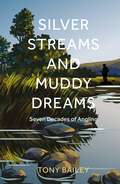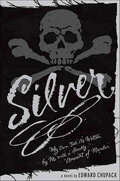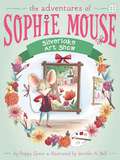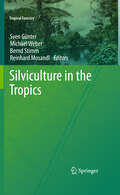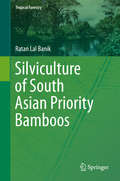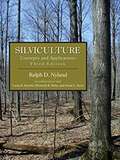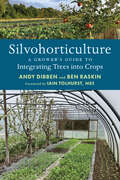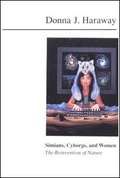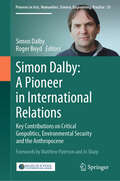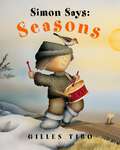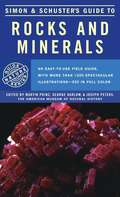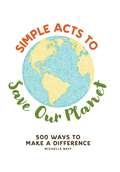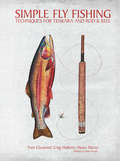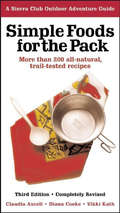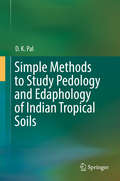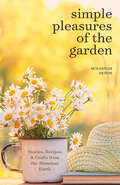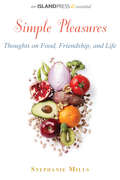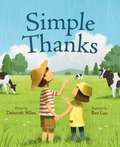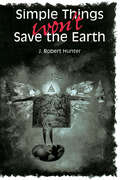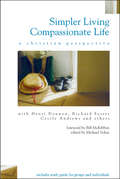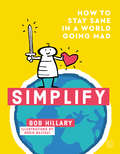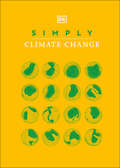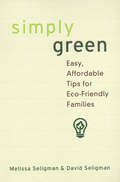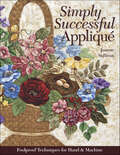- Table View
- List View
Silver Streams and Muddy Dreams: Seven Decades of Angling
by Tony Bailey‘A joyful drift through an angling life. Poignant meanders with plenty of hooks to snare any angler looking for literary immersion.’ – Kevin Parr, author of The Quiet Moon: Pathways to an Ancient Way of Being and Rivers Run: An Angler’s Journey From Source to SeaTony Bailey has been obsessed with fish his whole life (or, at least, what he can remember of it). As he reached his preteen years, this turned into a love for angling, which has stayed with him throughout his life and ensured he would spend the next seventy-odd years gladly indulging in his passion. In Silver Streams and Muddy Dreams, he looks back over a life spent fishing and considers what lights the spark that turns a human being into an angler – circumstance, social contact or genetics?Packed with memories and peppered with useful tips and observations, Tony explores the full gamut of angling possibilities, from the wildest stream to the most enigmatic of farm ponds, each tied to their histories and legends and each capable of providing the thrill of a lifetime or the peace and tranquillity to connect with nature and soothe the mind.
Silver: My Own Tale As Written by Me with a Goodly Amount of Murder
by Edward ChupackI am Silver, and there is no other pirate like me on these waters.This being the last testament of the infamous pirate Long John Silver, you would do well not to trust a word in its pages. Held captive aboard his own ship, the Linda Maria, he is to be taken to England, where he will hang at the king's pleasure. But he has another plan: to tell a tale of treason, murder, a lost treasure that would rival King George's own riches, and what really happened on Treasure Island . . . if Long John Silver is to be believed. But is he?His beginnings as a pickpocket on the streets of Bristol are as dark as the rest of his deliciously devious life. Taken to sea by the pirate captain Black John, Silver soon learns the arts of his trade: the sword, saber, and pistol. He makes his trade in plundering, cheating, ransacking, and murder---more murders than he can bother to count. British, Frenchmen, Spaniards, and Portuguese all fall before him. He takes exceptional pleasure in murder, but never such pleasure as he finds in his search for a most uncommon treasure. To find that treasure he must heed the words of a dead man, solve the ciphers in a well-worn Bible, forgo the love of an extraordinary woman, and climb over the corpses of friend and foe alike to arrive at Treasure Island and find his fortune.But Silver's tricks are never done. Before he greets the hangman at Newgate Square, he will have one last secret to reveal. Hidden in these pages are clues that lead to his remarkable discovery. And although King George's bounty for this notorious scourge may be handsome indeed, the captain who has captured Silver would not mind adding Silver's riches to his own purse. He will let Silver tell his tale in the hope of learning clues to the treasure's location. And if you were to mark his words as well, you might discover the whereabouts of that treasure yourself. So we shall, for now, allow Long John Silver to spin his stories, tales of adventure and betrayal, gold and jewels, love and murder.And he will never leave out the murder. Not Long John Silver.
Silverlake Art Show (The Adventures of Sophie Mouse #13)
by Poppy GreenIn this thirteenth charming book of The Adventures of Sophie Mouse series, Sophie hosts the very first Silverlake Art Show!Sophie has a brilliant idea: she&’s going to host the very first Silverlake Art Show! After all, she loves to draw and paint and she likes looking at art too. With the help of Hattie Frog and Owen Snake, Sophie puts together the whole event. And when the big night comes, she expects to be the star of the show. But she gets a surprise when she realizes…she&’s not! Who is this mystery artist that everyone is chirping and buzzing about? With easy-to-read language and illustrations on almost every page, the Adventures of Sophie Mouse chapter books are perfect for beginning readers.
Silviculture in the Tropics
by Michael Weber Bernd Stimm Reinhard Mosandl Sven GünterThis book integrates the latest global developments in forestry science and practice and their relevance for the sustainable management of tropical forests. The influence of social dimensions on the development of silvicultural concepts is another spotlight. Ecology and silvicultural options form all tropical continents, and forest formations from dry to moist forests and from lowland to mountain forests are covered. Review chapters which guide readers through this complex subject integrate numerous illustrative and quantitative case studies by experts from all over the world. On the basis of a cross-sectional evaluation of the case studies presented, the authors put forward possible silvicultural contributions towards sustainability in a changing world. The book is addressed to a broad readership from forestry and environmental disciplines.
Silviculture of South Asian Priority Bamboos
by Ratan Lal BanikThis monographaims at bringing out a comprehensive collection of information on bamboovarieties in South Asia. The main focus of this book is to address theecological and economic significance of bamboos. Bamboo is a versatile group of plants, capable of providing ecological,economic and livelihood security to the people. In the tropics, especially therural areas in different countries of South Asia, most of the houses aremade of bamboos. In the hilly areas of Bangladesh, Bhutan, Nepal and India, thetribal people take bamboo shoots as one of their major food items sinceprehistoric days. With palatableshoots and grass like leaves bamboo plants have also been liked by many herbivore animals, such as, elephants,the wild cattle, Indian Bison, and some speciesof deer. The red-panda in the Himalayas, and primates,pigs, rats and mice, porcupines, and squirrels are also incidental feeders onsoutheast Asian bamboos. There has been a growing awareness in recent years about the values ofbamboo being an important means of economic growth and for improving thesocio-economic conditions of the rural poor. Bamboo as an industrialmaterial can substitute wood and that to at low cost. Due to increasing demandand squeezing of bamboo area the plants have been overexploited and the qualityand quantity of resource alarmingly getting depleted. Besides many new bamboobased industries have come up which also urgently require uninterrupted supplyof species wise bamboo resource. The south Asia region has bestowed with more than 300 bamboospecies with enormous diversities at species, ecological and geneticallevel. A number of bamboo species are found common among countriesof the region selected for various utilization potentials having wide range of ability to adjustenvironmental conditions of these countries and thus prioritized forcultivation. Both government and private planters in the region have started allocating funds, land andother logistics to raise large scale plantation of desired bamboospecies. This book has been drafted to find out answers of the most pertinentqueries based on the field observations on each of the bamboo species andknowledge learnt from the indigenous people living with bamboos in differentparts of south-east and south Asian countries. This monograph would beinteresting and useful to bamboo professionals, foresters, horticulturists,field level extension workers, nurserymen, planters, industrial entrepreneurs,ecologists, and valuable source of reference to the relevant researchers andstudents in the region.
Silviculture: Concepts And Applications
by Ralph D. NylandSilviculture: Concepts and Applications reflects a belief that all the tools of silviculture have a useful role in modern forestry. Through careful analysis and creative planning, foresters can address a wide array of commodity and nonmarket interests and opportunities while maintaining dynamic and resilient forests. A landowner's needs, circumstances, and site conditions guide a silviculturist's judgment and decision making in finding the best ways to integrate the biologic-ecologic, economic-financial, and managerial-administrative requirements at hand. The Third Edition of this influential text provides a foundational basis for rigorous discussion of techniques. The inclusion of numerous real-world examples and balanced coverage of past and current practices broadens the concept of silviculture and the ways that managers can use it to address both traditional and emerging interests in forests. A thorough discussion of new and proven interpretations increasingly directs the attention of foresters toward the role silviculture plays in creating, maintaining, rehabilitating, and restoring forests that can sustain an expanding variety of ecosystem services.
Silvohorticulture: A grower's guide to integrating trees into crops
by Andy Dibben Ben Raskin"Dibben and Raskin offer an insightful, inspiring but also exceptionally practical guide to integrating trees into annual cropping systems. . . in this book we see how the phrase 'the sky’s the limit' has never been more applicable."—Jesse Frost, author of The Living Soil Handbook An invaluable handbook for farmers, growers, and gardeners, Silvohorticulture is the first book to offer a detailed, practical guide on how to effectively integrate trees with vegetable growing, offering information previously known only in the foresting world. Drawing on the decades-long experiences of Ben Raskin and Andy Dibben, both of whom have designed and managed agroforestry systems and have extensive experience in commercial horticultural crop production, this is the definitive book on the interaction between trees and crops, covering the benefits of trees for edible crops and the potential for additional crops from trees, plus crucial new information on how to fit trees into complex crop rotations as well as manipulating access to light. Ben and Andy also reveal the latest research on how tree roots behave and, importantly, how that impacts your crops. Agroforestry can bring immense benefits to farmers and growers—not just optimizing yield, but also improving soil, managing pests and water, increasing biodiversity, and reducing costs. System design must be customised to each grower’s requirements, and Silvohorticulture offers step-by-step detail that will allow you to manage your trees and crops successfully. "In this immensely practical guide, the authors provide the technical details towards integrating trees with vegetables and other crops, all while dispelling any preconceived notions that this idea reduces productivity or function. In fact, these systems might prove essential for farm resilience in a changing climate."—Steve Gabriel, author of Silvopasture
Simians, Cyborgs, and Women: The Reinvention of Nature
by Donna J. HarawayA collection of ten essays written mostly during the eighties. With a feminist perspective and the premise that nature is constructed, rather than discovered-- and that truth is made, not found-- Haraway provides an analysis of the popular and scientific struggles involved in the telling of evolutionary tales. The author is a historian of science at the U. of California, Santa Cruz.
Simon Dalby: Key Contributions on Critical Geopolitics, Environmental Security and the Anthropocene (Pioneers in Arts, Humanities, Science, Engineering, Practice #35)
by Simon Dalby Roger BoydThis book profiles Simon Dalby’s academic contributions in the fields of critical geopolitics, environmental security and the intersection of international relations and the Anthropocene. It includes reprints of key essays that highlight innovations in critical thought at the intersections between geopolitics, environment and security. Starting with an analysis of American reconstructions of the Soviet threat in the 1970s, an early contribution to the emerging field of critical geopolitics, subsequent papers focus on the emergent formulations of environmental security in the aftermath of the Cold War and the environmental costs of globalization. Focusing on the implicit geographical framing in discourses of globalization offered a critique that extended the ambit of critical geopolitics to grapple with the issues of environmental security and the rising concern with climate change as well as the political identities invoked in that debate. In the aftermath of 9/11, similar arguments about contextualization applied to the American global war on terror and the revival of discussions of empire and its geographies, both in arguments for invading Iraq, as well as the wider discussions in policy discourse and popular culture. Simultaneously, the emergence of earth system science and the concept of the Anthropocene offered another way to highlight the dangers of fossil fueled economic activities. The necessity of fundamentally rethinking the premises of security policy in light of this recontextualization is emphasized in more recent contributions on climate security and the current ecological crisis. Critical geopolitics Environmental security Global war on terror Firepower in the Anthropocene
Simon Says: Seasons (Simon)
by Gilles TiboMeet Simon, a little boy with big dreams. His imagination leads him to all kinds of wonderful adventures. With the help of his friend, Marlene, and with his own special spirit, Simon makes each season a memorable one.Simon welcomes spring — As the snow begins to melt, Simon decides he will hurry spring’s arrival. When his drum fails to call it forth, he tries fantastic but charmingly imaginative ways to pull flowers from the earth, tempt birds to return, and encourage bears to awaken — only to discover that spring will come in its own time, despite what we try to do to make it come any sooner.Simon in summer — Simon loves summer so much that he never wants it to end. When he sees the first signs of fall, he seeks advice from a heron and a cow, who tell him how to make summer last. Simon tries by making the frogs sing, pleasing the butterflies with paper flowers, and keeping the sun high in the sky.Simon and the wind — Simon tries to use the wind to fly. As he blows bubbles into the breeze, he thinks he can make one large enough to carry him. His friend Marlene brings him a cardboard box, and Simon asks the birds to carry it like a plane across the sky. Finally, Simon learns he cannot fly, but discovers a game he and his friends can play with the wind.Simon and the snowflakes — Simon is curious. He wants to know how many snowflakes fall in a snowstorm, but they come down too fast to count. When he learns that there are as many snowflakes as stars in the sky, he tries to count them too, but they race across the night sky. Simon decides to visit his friends in the forest and finds something much better to count there.
Simon and Schuster's Guide to Rocks and Minerals
by Simon Martin Prinz George Harlow Joseph Peters Annibale Mottana Rodolfo Crespi Giuseppe Liborio Schuster StaffAn easy to use field guide that contains everything rock and mineral enthusiasts need to know with more than 1,000 spectacular illustrations--600 in full color! Practical, concise, and easy to use, Simon & Schuster's Guide to Rocks and Minerals contains everything that the rock and mineral enthusiast needs to know. This field guide is divided into two large sections--one devoted to minerals and one to rocks, each prefaced by a comprehensive introduction that discusses formation, chemistry, and more. All 377 entries, beautifully illustrated with color photographs and helpful visual symbols, provide descriptions and practical information about appearance, classification, rarity, crystal formation, mode of occurrence, gravity of mineral, rock chemistry, modal classification fields, formational environments, grain sizes of rocks, and much more. Whether you are a serious collector or an information-seeking amateur, this incomparably beautiful, authoritative guide will prove an invaluable reference.
Simple Acts to Save Our Planet: 500 Ways to Make a Difference (Simple Acts Gift Series)
by Michelle NeffSimple Acts to Save Our Planet shows you how to be more active in saving our planet every day by performing some &“Simple Acts of Kindness&”—for the Earth.Treat the environment with kindness with these easy, manageable activities that range from simple home updates, to gardening basics, to supporting the local community. You&’ll learn simple techniques to help protect the planet every day, like starting a compost pile to reduce food waste, utilizing travel mugs and reusable containers, and choosing eco-friendly products. By working to implement these simple strategies into your everyday life, you can take an active stand to protect the environment now— and make a real difference for the future.
Simple Fly Fishing
by James Prosek Yvon Chouinard Craig Mathews Mauro Mazzo Russell ChathamModern-day fly fishing, like much in life, has become exceedingly complex, with high-tech gear, a confusing array of flies and terminal tackle, accompanied by high-priced fishing guides. This book reveals that the best way to catch trout is simply, with a rod and a fly and not much else. The wisdom in this book comes from a simpler time, when the premise was: the more you know, the less you need. It teaches the reader how to discover where the fish are, at what depth, and what they are feeding on. Then it describes the techniques needed to present a fly at that depth, make it look lifelike, and hook the fish. With chapters on wet flies, nymphs, and dry flies, its authors employ both the tenkara rod as well as regular fly fishing gear to cover all the bases. Illustrated by renowned fish artist James Prosek, with inspiring photographs and stories throughout, Simple Fly Fishing reveals the secrets and the soul of this captivating sport.
Simple Foods for the Pack: More than 200 All-Natural, Trail-tested Recipes
by Claudia Axcell Bob Kinmont Diana Cooke Vikki Kinmont KathThis latest edition of the original--and best--natural foods backpacking cookbook features a wealth of new recipes and mouthwatering classics, as well as the most current information on cooking with today's lightweight foods and equipment. This unique cookbook brings together the expertise of culinary professionals and the wilderness knowledge of a former backcountry guide to provide more than 180 trail-tested recipes for delicious, natural, and easy-to-prepare meals for backpacking, hiking, and camping. Since Sierra Club Books published the first edition of Simple Foods for the Pack in 1976, there has been a revolution in backcountry cooking. Today's lightweight stoves and kitchen tools make cooking in the wild easier than ever before. And with the ubiquitous availability of fast-cooking natural foods, the modern adventurer has tasty alternatives to the expensive pre-packaged meals that are on the market.Focusing on these natural foods and the latest equipment, this newly revised edition offers hikers gourmet taste at every meal--from Oatmeal Hotcakes for breakfast, to homemade "nutrition bars" for the trail, to Beer Fondue back at camp. The wide variety of menus and the expanded guide to planning, packing, and preparing food make cooking in the backcountry as easy as High Mountain Pie.
Simple Methods to Study Pedology and Edaphology of Indian Tropical Soils
by D. K. PalThis book discusses how research efforts have established an organic link between pedology and edaphology of five pedogenetically important soil orders as Alfisols, Mollisols, Ultisols, Vertisols and Inceptisols of tropical Indian environments. The book highlights how this new knowledge was gained when research efforts were complemented by high resolution mineralogical, micro morphological and age-control tools. This advancement in basic and fundamental knowledge on Indian tropical soils makes it possible to develop several index soil properties as simple methods to study their pedology and edaphology. More than one-third of the world’s soils are tropical soils. Thus the recent advances in developing simple and ingenuous methods to study pedology and edaphology of Indian tropical soils may also be adopted by both graduate students and young soil researchers to aid in the development of a national soil information system to enhance crop productivity and maintain soil health in the 21st century.
Simple Pleasures of the Garden: Stories, Recipes & Crafts from the Abundant Earth (Simple Pleasures Ser.)
by Susannah SetonSimple Pleasures Throughout the Year “Simple Pleasures has become my go-to book for remembering to slow down and enjoy the little things in life.” —Becca Anderson, bestselling author of Badass Affirmations, The Book of Awesome Women, and moreAn abundant sourcebook of ideas, encouraging quotes, recipes, and soothing activitiesSimple Pleasures of the Garden shows you how to appreciate the simple things within your daily activities. The secret to living well year round can be found in the abundance of your home garden, so get to planting those seeds of simple joys and herbal healing! Nurture your mind, body, and soul. Sometimes finding the positive can be hard, but it doesn’t have to be. From the recipe for a homemade herbal bath for a spa day to quick and easy recommendations for an instant room makeover, the suggestions and home recipes collected in this book offer a new appreciation for the everyday activities that nurture and comfort you.Simplify your emotional self care. Taking care of yourself doesn’t have to be expensive, unrealistic, or inaccessible. It can be as easy as tending to a green garden, making healing herbal tonics, sipping calming teas, or spending time with other natural energy boosters. Pleasures are made, not bought, so unlock new secrets to happiness with these touching stories, practical tips, and satisfying crafts. Inside this positive attitude book you’ll find: Ways to decorate your home with nature crafts, growing herbs, and an air of magic Advice on how to foster a routine for a rejuvenating self care yearTips on how to become the gardener of your moods and emotionsIf you liked seasonal self care books like A Year of Self-Care, Grow Your Own Medicine, or A Woman’s Garden, you’ll love Simple Pleasures of the Garden.
Simple Pleasures: Thoughts on Food, Friendship, and Life (Island Press E-ssentials)
by Stephanie MillsIn Simple Pleasures: Thoughts on Food, Friendship, and Life we have highlighted two chapters from Stephanie Mill's reflection the pleasures, as well as the virtues and difficulties, of a perhaps simpler than average North American life. It is a thoughtful paean to living, like Thoreau, a deliberate life. Mill's writing is beautifully crafted, fluid, inspiring, and enlightening, and these chapters encourage you to take a moment to reflecton your own life. It celebrates the pleasures, beauty, and fulfillment of a simple life, a goal well worth striving for.
Simple Thanks
by Deborah WilesFrom award-winning author Deborah Wiles and illustrator Bao Luu comes an exuberant and heartwarming picture book tribute to the things that connect us all—nature, love, and gratitude. I hear the song that nature singsthat links each heart to mine.The ocean blue, the sky abovethe forest with its pine.For a young brother and sister, every day spent in nature is an adventure, and every natural marvel they encounter is a gift. Together, they run through fields of tall grass and say thank you for the rain; they greet fish in babbling brooks and say thank you for the clear blue waters. At the end of each adventure, they say thank you for the new friends they collected along the way.When given a chance to do more than say thank you, the siblings gather their tools—their friends, their shovels, and their watering cans—and plant the seeds of gratitude.
Simple Things Won't Save the Earth
by J. Robert HunterWe drive cars with "Save the Whales" bumper stickers, buy aerosol sprays that advertise "no chlorofluorocarbons," and wear T-shirts made from organically grown cotton. All of these "earth friendly" choices and products convince us that we are "thinking globally, acting locally" and saving the planet. But are we really? In this provocative book, J. Robert Hunter asserts that using catchy slogans and symbols to sell the public on environmental conservation is ineffective, misleading, and even dangerous. Debunking the Fifty Simple Things You Can Do to Save the Earth approach, Hunter shows that there are no simple solutions to major environmental problems such as species extinction, ozone depletion, global warming, pollution, and non-renewable resource consumption. The use of slogans and symbols, Hunter argues, simply gives the public a false sense that "someone" is solving the environmental crisis—while it remains as serious now as when the environmental movement began. Writing in plain yet passionate prose for general readers, he here opens a national debate on what is really required to preserve the earth as a habitat for the human species.
Simple Things Won't Save the Earth
by J. Robert HunterWe drive cars with "Save the Whales" bumper stickers, buy aerosol sprays that advertise "no chlorofluorocarbons," and wear T-shirts made from organically grown cotton. All of these "earth friendly" choices and products convince us that we are "thinking globally, acting locally" and saving the planet. But are we really?<P><P>In this provocative book, J. Robert Hunter asserts that using catchy slogans and symbols to sell the public on environmental conservation is ineffective, misleading, and even dangerous. Debunking the Fifty Simple Things You Can Do to Save the Earth approach, Hunter shows that there are no simple solutions to major environmental problems such as species extinction, ozone depletion, global warming, pollution, and non-renewable resource consumption.
Simpler Living, Compassionate Life: A Christian Perspective
by Bill Mckibben Michael SchutEssays on the spiritual power of an uncluttered life from Henri Nouwen, Richard J. Foster, Juliet Schor, and others, with an introduction by Bill McKibben. Every day we are bombarded with messages that imply we need more: more money, more clothes, more food, more cars, more everything. But despite technological advances, proliferation of resources, and a general increase in what the average person has, our happiness has not grown at the same rate as our stash of stuff. Perhaps the key to a good life isn’t found in quantity but in quality—and in a simple, honest approach to existence. In Simpler Compassionate Living, Michael Schut brings together brilliant essays on the topic of modest lifestyles from twenty-three luminaries, including Terry Tempest Williams, Cecile Andrews, Wendell Berry, and Evy McDonald . Delving into topics such as time as a commodity, money in modern society, international economics, social and environmental responsibility, and the ever-widening global community, these compositions present a framework for examining and reforming how we view our place in a world obsessed with commerce and consumerism. With a study guide and an appendix of further resources for those who want to take steps to change their lifestyle, Simpler Compassionate Living is a comprehensive look at how to step outside of the madness of materialism and rediscover the peace and fulfillment within—replacing the fleeting rush of acquisitiveness with a genuinely sustainable joy. Also includes essays by: Shantilal Bhagat, Frederick Buechner, John B. Cobb, Jr., Michael Schut, Alan Durning, James T. Mulligan, William Gibson, Gerald May, Timothy Weiskel, Calvin DeWitt, Duane Elgin, Philip Sherrard, William Stringfellow, Jerome Segal, David Shi
Simplify: How to Stay Sane in a World Going Mad
by Bob HillaryShort, simple and refreshingly practical, Living Simply offers 21 Earth Warrior practices to help us live more consciously and to cope with the ever increasing pace of modern life. Bob Hillary shares the lessons he learned living off the grid, exploring his &‘wild edges&’ and practicing a slower, more attuned way of life.How can we live more simply, learn to appreciate what we have and root our way of being in the Earth we have inherited? By living simply and becoming an Earth Warrior.As life keeps urging us to go faster, many of us are moving in the opposite direction... we are looking for SLOWNESS, for stillness, to live more natural, less complex lives. Bob Hillary spent a year living off grid, this experience taught him how to live simply. It meant; downscaling, re-wilding, un-teching and finding and doing things that are free. These philosophies provided a framework for the 21 practices he shares in this book. Each one covers the key idea, contains exercises and provides practical ways that will help you become an Earth Warrior. By living this way you will learn how to live in a more joyful, positive, simple and meaningfully way. Earth Warriors give, share and care.This is a manual for modern times, a guide to creating positive action, walking the right path and making the right choices.
Simply Climate Change (DK Simply)
by DKUnderstand climate change like never before!Explore and understand the intriguing science behind climate change. Gain valuable knowledge on why climate change is occurring — one of the planet&’s most challenging issues — and analyze possible solutions.Simply Climate Change is the perfect guide for a clear and concise understanding of the often complex subject of climate change. Inside you&’ll find: • Simple, easy-to-understand graphics which help convey information in a visual way. • Clear, authoritative text that explains over 100 key concepts. • Concise explanations that quickly convey the most important information. • Technologies and practical ideas to combat climate change. • Debates surrounding climate change as a political, social, economic and environmental issue. Gain a new appreciation for our precious planet, and acquire newfound knowledge on climate change. This easy-to-understand climate change book will allow you to grasp all these topics quickly, from the basics of greenhouse gases to microplastics and insightful debates.The guide combines clear text and bold graphics, divided into pared-back, single or double-page entries that explain concepts simply and visually. Whether you&’re a student and want an easy-to-read, jargon-free reference or are simply interested in climate or environmental science, then this is the ideal global warming book for you!The most accessible guide to climate change on the market will have you knowledgeable on the subject like an expert! This is a perfect reference book for busy readers looking for an easier way into the subject, as a self-purchase or an excellent gift for self-improvers, as well as for thinkers, borrowers and life-long learners.
Simply Green: Easy, Money-Saving Tips for Eco-Friendly Families
by Melissa Seligman David SeligmanWritten by a passionately concerned couple--David Seligman is an active duty U.S. serviceman and Melissa is a devoted stay-at-home mom--this is the first book about going green that won't scare you with statistics, overwhelm you with science, or make you feel guilty about your SUV. Instead, this indispensable guide will help families everywhere to take simple, practical steps, to lower their energy consumption and help create a healthier planet--and a more sustainable lifestyle. Simply Green takes a fresh look at every part of your household and every aspect of your life, from what you teach your children to what you put in your laundry machines. Full of energy-saving and money-saving "Green Tips," Simply Green shows how to: * Use recycled water around your house and garden * Heat and cool your home while you lower your energy bill * Throw away less trash * Make your own, environmentally-friendly cleaning solutions * Lower the power usage of your appliances * Choose indoor houseplants that help purify the air * Make green awareness an active part of your family's life--and have more fun in the natural world * And much more! Filled with dozens of useful resources, surprising facts and a long list of options for "going green," Simply Green is for those of us who may not be able to afford to make huge changes--but can't not afford to do what we can.
Simply Successful Appliqué: Foolproof Techniques For Hand & Machine
by Jeanne SullivanJust 15 minutes to perfection! Learn new appliqué skills and get pinpoint accuracy more easily than ever before in this comprehensive visual guide with a bonus CD of full-size template patterns. Anyone can learn Jeanne's stress-free process and use her simplified, success-oriented methods, even if you've been shy in the past about trying appliqué. Seasoned quilters and sewers will also love using these new techniques for more complex designs. • Learn Jeanne's method for flawless appliqué in just minutes-by hand or machine • Easier and faster techniques for ruching, circles, narrow lines, lettering, Broderie Perse, reverse appliqué, and more • What you see is what you get…work with all your fabrics and templates right side up
